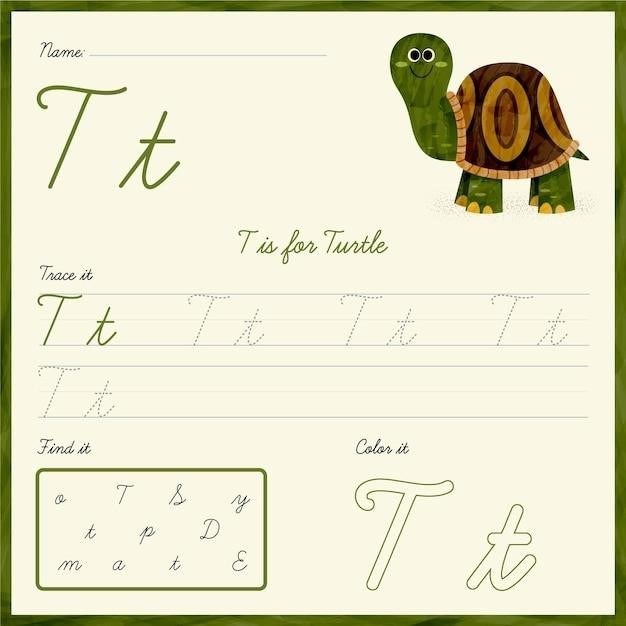Tap drill size charts provide essential guidelines for selecting the correct drill bit size when creating screw threads․ They cover both metric and inch measurements, ensuring precise alignment․ These charts are crucial for achieving accurate thread dimensions in manufacturing processes, preventing errors and ensuring proper fitment of screws and taps․ Available in PDF formats, they offer a quick reference for engineers and mechanics, making them indispensable tools in machining and fabrication tasks․ Their use ensures consistency and reliability in producing threaded components across various industries․
Overview of Tap Drill Size Charts
Tap drill size charts are detailed reference tools used to determine the correct drill bit size for creating screw threads․ They provide measurements for both metric and inch systems, ensuring compatibility with various thread standards․ These charts list the recommended drill diameters for different tap sizes, helping to achieve precise thread fitment․ Available in PDF formats, they are widely used in machining and manufacturing to avoid errors in thread production․ By offering a clear and organized layout, tap drill charts simplify the selection process, making them indispensable for engineers, mechanics, and DIY enthusiasts․ Their accuracy ensures proper material compatibility and thread quality, making them a fundamental resource in fabrication processes․
Importance of Using Tap Drill Size Charts
Using tap drill size charts is crucial for ensuring accuracy and precision in thread creation․ Proper drill sizing prevents common issues like tap breakage, thread misalignment, and material damage․ These charts guide users to select the correct drill bit diameter for specific tap sizes, ensuring threads fit securely․ They minimize production errors, reducing waste and saving time․ Available in PDF formats, they serve as quick references for engineers and mechanics․ Accurate thread production enhances product quality and reliability, making these charts essential for maintaining high standards in manufacturing․ Their use is vital for achieving consistent and reliable results in both metric and inch-based applications, ensuring optimal performance in assembled components․

Understanding Tap Drill Sizes
Tap drill sizes are guides for selecting the correct drill bit to match tap dimensions, ensuring precise thread creation․ They cover metric and inch systems, providing exact sizing for various applications․
What is a Tap Drill Size Chart?
A tap drill size chart is a comprehensive guide that provides the correct drill bit sizes for creating screw threads․ It correlates drill sizes with tap sizes, ensuring precise alignment and proper thread dimensions․ These charts are available in both metric (mm) and inch measurements, catering to different standards and applications․ They often include tables listing nominal tap sizes, corresponding drill diameters, and decimal equivalents․ Tap drill charts are essential for machinists and engineers to achieve accurate thread production․ They are widely used in manufacturing, fabrication, and repair processes, offering a quick reference to avoid errors․ Printable PDF versions are popular for convenience and ease of use in workshops and industries;
Metric vs․ Inch Measurements in Tap Drill Charts
Metric and inch measurements are two standard systems used in tap drill charts, catering to different regions and industries․ Metric charts use millimeters for drill and tap sizes, while inch charts use fractional or decimal inches․ Both systems provide equivalent sizes to ensure compatibility and accuracy in threading operations․
The metric system is widely adopted in international manufacturing, offering precise measurements for taps and drills․ Inch measurements are commonly used in the United States and other countries that follow imperial standards․ Tap drill charts often include both systems side by side, allowing for easy conversion and reducing errors․ This dual-system approach ensures global compatibility and flexibility in machining processes․

Key Terms and Definitions
Understanding key terms is essential for effectively using tap drill size charts․ The tap drill size chart is a reference guide that specifies the correct drill bit size for creating screw threads․ Major diameter refers to the largest diameter of the screw thread, while minor diameter is the smallest․ Pitch is the distance between consecutive threads, and TPI (Threads Per Inch) indicates thread density․ Drill bit size is the diameter of the hole drilled before tapping․ These terms are fundamental for ensuring accurate thread creation in both metric and inch systems․ Proper understanding prevents errors and ensures compatibility in machining processes․

Types of Taps and Drill Sizes
Taps are classified into cutting and forming types, each suited for specific threading applications․ Drill sizes are standardized for both metric and inch systems, ensuring precise thread creation․
Cutting Taps vs․ Forming Taps
Cutting taps remove material to create threads, while forming taps shape the material without removing it․ Cutting taps are commonly used for most materials, including metals and plastics, and are designed for through or blind holes․ They come in various flute types, such as spiral fluted taps for threading in deep holes and fast helix taps for high-performance machining; Forming taps, on the other hand, are specialized for materials like aluminum, brass, and plastics, where the thread is formed by displacing material rather than cutting it․ This method produces stronger threads but requires precise control to avoid material deformation․ Both types have specific applications and are essential in achieving high-quality threaded parts․ Their selection depends on the material, thread type, and desired outcome․ Proper usage ensures efficient and accurate threading operations․ Always refer to tap drill charts for compatible drill sizes to maintain thread accuracy and prevent damage․
Standard Tap Drill Sizes for Metric Threads
Standard tap drill sizes for metric threads are determined based on the nominal diameter and pitch of the thread․ These sizes ensure proper thread fitment․ For example, M1․6, M2, M2․5, and M3 threads commonly use drill diameters of 1․25mm, 1․6mm, 2․05mm, and 2․5mm respectively․ The charts provide precise measurements, ensuring minimal material removal and accurate thread formation․ They are widely available in PDF formats, making them easily accessible for engineers and machinists․ Proper alignment and sizing are crucial, as incorrect drill sizes can lead to thread inaccuracies․ Always refer to a reliable metric tap drill chart for specific thread specifications, ensuring optimal results in manufacturing processes․ This ensures high-quality outcomes in producing threaded components for various applications and industries․
Standard Tap Drill Sizes for Inch Threads
Standard tap drill sizes for inch threads are designed to ensure precise thread creation in materials․ These charts list the recommended drill diameters for various thread sizes, such as 1/2-20, 3/4-16, and 1-12 threads․ For example, a 1/2-20 thread typically requires a drill size of 0․4531 inches, while a 3/4-16 thread uses a 0․6875-inch drill․ These sizes are standardized to match the thread’s major diameter, ensuring proper fitment․ The charts also provide decimal equivalents for easy reference․ They are widely available in PDF formats, offering a quick guide for engineers and machinists․ Using the correct drill size prevents thread errors and ensures accurate screw fitment․ These charts cover a range of thread sizes, from coarse to fine pitches, making them essential for precise machining operations in various industries․

How to Choose the Right Tap Drill Size
Selecting the correct tap drill size involves using charts to match thread type and material․ Ensure accurate alignment and thread quality by referencing metric or inch-specific charts, avoiding errors․
Factors Influencing Tap Drill Size Selection
Several factors influence the selection of the correct tap drill size․ The thread type, whether metric or inch, and its specific pitch are primary considerations․ Material properties, such as hardness and elasticity, also play a crucial role in determining the appropriate drill size․ The desired thread class, which specifies the tolerance level, further narrows down the options․ Additionally, the type of tap—whether it’s a cutting or forming tap—affects the drill size․ Using a tap drill size chart ensures that all these factors are accounted for, providing the precise drill size needed for accurate thread creation and preventing common machining errors․ Proper selection enhances thread quality and tool longevity․
How to Read a Tap Drill Size Chart
Reading a tap drill size chart involves identifying the correct drill size for a specific tap․ The chart typically lists tap sizes, both in metric and inch measurements, alongside corresponding drill sizes․ For metric threads, the chart provides the nominal diameter and pitch, followed by the recommended drill diameter․ Similarly, for inch threads, it offers the tap size and the closest decimal equivalent drill size․ Users should match their tap size to the chart to find the appropriate drill size, ensuring precise alignment․ Some charts also differentiate between cutting and forming taps, offering specific drill sizes for each type․ Proper interpretation ensures accurate thread creation and avoids common errors during machining processes․
Metric Tap Drill Sizes and Decimal Equivalents
Metric tap drill sizes are standardized to ensure compatibility with screw threads in manufacturing․ Charts list nominal diameters, pitches, and corresponding drill sizes in millimeters and inches․ For example, M1․6 threads require a 1․25 mm drill, while M2 threads use a 1․6 mm drill․ Decimal equivalents are provided for precision, such as 0․049 inches for M1․6․ These charts cover a range of sizes, from M1․6 to M27, and differentiate between coarse and fine pitches․ They also specify drill sizes for cutting and forming taps, ensuring proper thread creation․ By referencing these charts, engineers can avoid errors and achieve precise thread fitment․ Downloadable PDF versions are widely available for easy use in workshops and design processes․
Inch Tap Drill Sizes and Decimal Equivalents
Inch tap drill size charts provide precise measurements for selecting the correct drill bit when working with inch-based screw threads․ These charts list drill sizes in inches and their decimal equivalents, ensuring accuracy in machining․ For example, a 1/4-20 thread requires a 7/16 inch drill bit, equivalent to 0․4375 inches․ Charts cover a range of sizes, from #0 to 1 inch, and beyond, offering a quick reference for engineers․ The decimal equivalents simplify calculations, especially when converting between fractions and decimals․ Printable PDF versions are widely available, making it easy to reference these sizes in workshops or design processes․ This ensures consistency and accuracy in creating screw threads for various applications․

Materials and Their Impact on Tap Drill Sizes
The material’s hardness and elasticity influence tap drill size selection․ Harder materials require smaller drills, while softer materials need larger drills to ensure proper thread fitment and durability․
Tap Drill Sizes for Metal Materials
The selection of tap drill sizes for metal materials depends on the specific properties of the metal, such as hardness, elasticity, and ductility․ Softer metals, like aluminum or brass, typically require larger drill sizes to accommodate thread formation without causing material deformation․ Harder metals, such as steel or titanium, may need slightly smaller drills to ensure precise thread engagement․ The drill size must also account for the desired thread fit—loose or tight—to prevent tapping errors or tap breakage․ Standard charts often list specific drill diameters for common metals, ensuring optimal results․ Always refer to material-specific charts for precise measurements․
Tap Drill Sizes for Plastic and Composite Materials
Tap drill sizes for plastic and composite materials are selected based on the material’s flexibility and strength to prevent cracking or deformation․ Softer plastics, like ABS or Nylon, often require slightly larger drill sizes to accommodate thread formation without causing material stress․ For harder or glass-filled composites, smaller drills may be necessary to maintain thread integrity․ It’s crucial to consider the material’s thickness and desired thread depth to avoid over-tapping․ Specialized charts for plastics and composites provide precise drill diameters, ensuring proper tap alignment and minimizing the risk of material failure․ Always consult material-specific guidelines to achieve optimal results in tapping operations for these unique substrates․

Using Tap Drill Charts for Specific Applications
Tap drill charts are essential for specific applications like screw threads and pipe fittings, ensuring accurate drill sizes and proper tap alignment to prevent errors and ensure durability․
Drill Sizes for Screw Threads
Drill sizes for screw threads are determined using standardized charts, ensuring precise alignment and proper fitment․ These charts list the recommended drill diameters for both metric and inch threads, aiding engineers in selecting the correct tools․ For screw threads, the drill size corresponds to the tap size, ensuring the thread will be accurately formed․ Metric charts typically reference ISO standards, providing drill sizes in millimeters, while inch charts use fractional or decimal measurements․ Proper alignment and accurate drill sizes prevent errors and ensure durability in manufacturing and assembling threaded components․ These charts are indispensable for ensuring consistency and reliability in producing screw threads across various industries and applications․
Drill Sizes for Pipe Threads
Drill sizes for pipe threads are specified to ensure leak-free connections in piping systems․ These sizes are typically outlined in dedicated charts, differing from standard screw threads due to the unique requirements of pipe fittings․ For metric pipe threads, such as those conforming to ISO standards, the drill diameter is carefully matched to the tap size to achieve the correct thread profile․ Similarly, inch-based pipe threads follow NPT or NPTF standards, requiring precise drill sizes to ensure proper sealing․ Using the correct drill size is critical to prevent leaks and maintain integrity in high-pressure or fluid-handling applications․ These specialized charts are essential for engineers and technicians working with pipe fittings, ensuring accurate and reliable results in various industrial settings․

Downloading and Using Tap Drill Size Charts
Tap drill size charts are widely available for download in PDF format, offering detailed tables for both metric and inch measurements․ These charts are free, printable, and essential for precise drilling operations․ They provide quick reference for selecting the correct drill sizes, ensuring accuracy and efficiency in various applications․ Engineers and technicians rely on these charts to streamline their workflows and maintain consistency in manufacturing processes․ Downloadable PDFs make it easy to access and use these critical resources anytime, anywhere․
Where to Find Tap Drill Size Charts in PDF Format
Tap drill size charts in PDF format are readily available for download from various engineering and manufacturing websites․ Websites like TemplateLab and ICS Cutting Tools offer comprehensive charts covering both metric and inch measurements․ These PDFs are designed to be printable and easy to use, providing detailed tables for quick reference․ Many resources, such as mechanical-engineering․com, offer free downloads specifically for metric tap drill sizes․ These charts often include ISO metric coarse and fine pitch threads, ensuring compatibility with international standards․ Engineers and technicians can easily access these documents to ensure accuracy and efficiency in drilling operations for screw threads and other applications․

How to Print and Use Tap Drill Charts
Printing and using tap drill charts is straightforward for efficient machining․ First, download the PDF from reliable sources like engineering websites or tools suppliers․ Ensure the chart is printed at actual size to maintain scale accuracy․ Laminate the chart for durability in workshop environments․ Use a ruler or digital caliper to measure drill sizes accurately․ Cross-reference the tap size with the recommended drill diameter for precise hole preparation․ Highlight frequently used sizes for quick access․ Regularly update the chart to stay current with industry standards․ This ensures consistent and accurate threading operations, reducing errors and improving productivity in manufacturing and DIY projects․

Best Practices for Tap Drilling
Always use the correct drill size for the tap to ensure accurate thread creation․ Maintain sharp tools to prevent wear and tear․ Ensure proper alignment and use coolant to minimize heat buildup and extend tool life․ Follow recommended feed rates and speeds for optimal results․ Regularly inspect tools and materials to avoid defects․ Properly secure the workpiece to maintain stability during drilling․ Adhere to safety guidelines to prevent accidents and achieve consistent, high-quality threading operations․
Common Mistakes to Avoid in Tap Drilling
One of the most common mistakes in tap drilling is using the wrong drill size, which can lead to incorrect thread dimensions․ Ensure the drill bit matches the tap size chart for precise alignment․ Dull or worn-out tools can result in poor thread quality or tap breakage․ Forgetting to use coolant or lubricant can cause excessive heat buildup, damaging the material or tool․ Drilling at incorrect feed rates or speeds may lead to thread inaccuracies or tool failure․ Always pre-drill pilot holes and center them accurately to avoid misalignment․ Over-tightening taps can strip threads, while under-tightening may result in loose connections․ Lastly, neglecting to consult tap size charts for specific materials can lead to mismatches and operational issues․ Avoiding these errors ensures reliable and precise tapping operations․
Ensuring Accuracy in Tap Drilling Operations
Accuracy in tap drilling operations is achieved by using precision tools and adhering to established guidelines․ Always select the correct drill bit size from a tap size chart, ensuring compatibility with the material and thread type․ Proper alignment of the drill press or machining center is critical to avoid misalignment․ Use high-quality taps and drills to minimize wear and tear․ Lubrication or coolant application is essential to reduce friction and prevent overheating․ Maintaining consistent feed rates and speeds helps in producing uniform threads․ Regularly inspect tools for wear and replace them when necessary․ Employing pilot holes and center drills enhances hole accuracy․ Finally, referencing detailed tap drill size charts specific to the material and thread standard ensures precise results, reducing errors and improving overall product quality in manufacturing processes․




Leave a Reply
You must be logged in to post a comment.